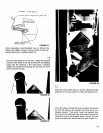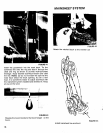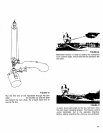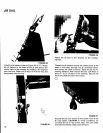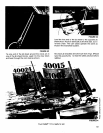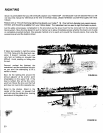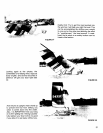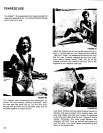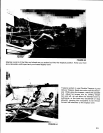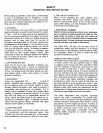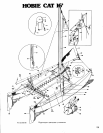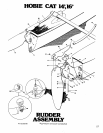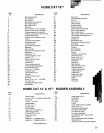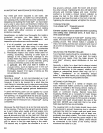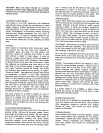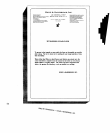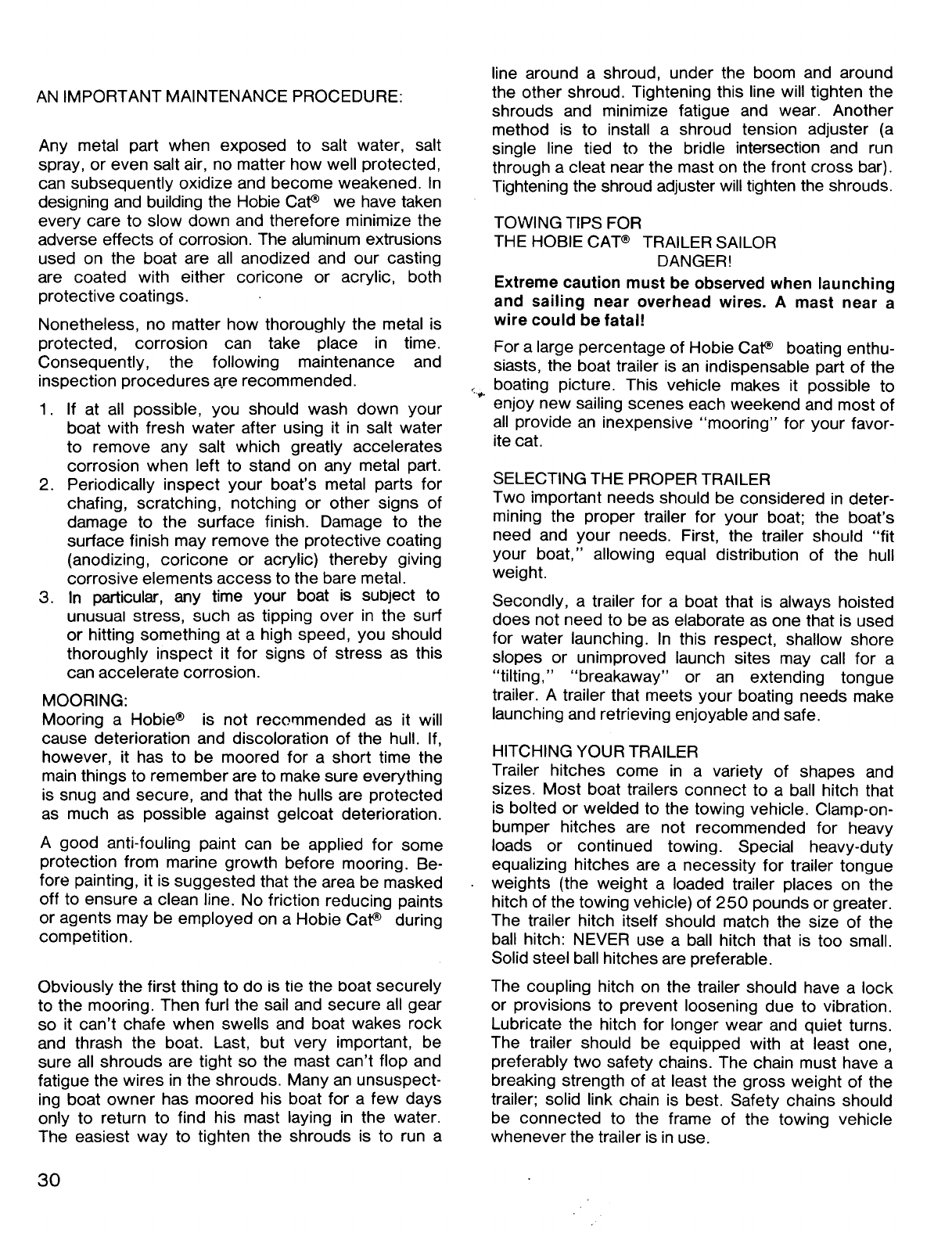
line around a shroud, under the boom and around
AN IMPORTANT MAINTENANCE PROCEDURE: the other shroud. Tightening this line will tighten the
shrouds and minimize fatigue and wear. Another
method is to install a shroud tension adjuster (a
Any metal part when exposed to salt water, salt single line tied to the bridle intersection and run
spray, or even salt air, no matter how well protected, through a cleat near the mast on the front cross bar).
can subsequently oxidize and become weakened. In Tightening the shroud adjuster will tighten the shrouds.
designing and building the Hobie Ca~ we have taken
every care to slow down and therefore minimize the TOWING TIPS FOR
adverse effects of corrosion. The aluminum extrusions THE HOBIE CAT@ TRAILER SAILOR
used on the boat are all anodized and our casting DANGER!
are co~ted wi:h either coricone or acrylic, both Extreme caution must be observed when launching
protective coatings. and sailing near overhead wires. A mast near a
Nonetheless, no matter how thoroughly the metal is wire could be fatal!
protected, corrosion can. take ~Iace in time. For a large percentage of Hobie Ca~ boating enthu-
Consequently, the following maintenance and siasts, the boat trailer is an indispensable part of the
inspection procedures are recommended. '. boating picture. This vehicle makes it possible to
1. If at all possible, you should wash down your" enjoy n~w saili.ng scen~s e~ch w~ek,~nd and most of
boat with fresh water after using it in salt water ~II provide an Inexpensive mooring for your favor-
to remove any salt which greatly accelerates Ite cat.
corrosion when left to stand on any metal part.
2. Periodically inspect your boat's metal parts for SEL~CTING THE PROPER TRAILER. .
chafing, scratching, notching or other signs of T~~ Important needs ~hould be considered In dete~-
damage to the surface finish. Damage to the mining the proper trailer for your boat; the boat s
surface finish may remove the protective coating need and your needs. First, the trailer should "fit
(anodizing, coricone or acrylic) thereby giving yo~r boat," allowing equal distribution of the hull
corrosive elements access to the bare metal. weight.
3. In particular, any time y~ur. boat is ~Ubject to Secondly, a trailer for a boat that is always hoisted
unusual stress, such as tipping over In the surf does not need to be as elaborate as one that is used
or hitting something at a high speed, you should for water launching. In this respect, shallow shore
thoroughly inspect it .for signs of stress as this slopes or unimproved launch sites may call for a
can accelerate corrosion. "tilting," "breakaway" or an extending tongue
MOORING: trailer. A trailer that meets your boating needs make
Mooring a Hobie@ is not recommended as it will launching and retrieving enjoyable and safe.
cause deterioration and discoloration of the hull. If,
however it has to be moored for a short time the HITCHING YOUR TRAILER
main things to remember are to make sure everything T:ailer hitches com.e in a variety of sha~es and
is snug and secure, and that the hulls are protected ~Izes. Most boat trailers conn~ct to ~ ball hitch that
as much as possible against gelcoat deterioration. IS bolted or welded to the towing vehicle. Clamp-on-
bumper hitches are not recommended for heavy
A good anti-fouling paint can be applied for some loads or continued towing. Special heavy-duty
protection from marine growth before mooring. Be- equalizing hitches are a necessity for trailer tongue
fore painting, it is suggested that the area be masked. weights (the weight a loaded trailer places on the
off to ensure a clean line. No friction reducing paints hitch of the towing vehicle) of 250 pounds or greater.
or agents may be employed on a Hobie Ca~ during The trailer hitch itself should match the size of the
competition. ball hitch: NEVER use a ball hitch that is too small.
Solid steel ball hitches are preferable.
Obviously the first thing to do is tie the boat securely The coupling hitch on the trailer should have a lock
to the mooring. Then furl the sail and secure all gear or provisions to prevent loosening due to vibration.
so it can't chafe when swells and boat wakes rock Lubricate the hitch for longer wear and quiet turns.
and thrash the boat. Last, but very important, be The trailer should be equipped with at least one,
sure all shrouds are tight so the mast can't flop and preferably two safety chains. The chain must have a
fatigue the wires in the shrouds. Many an unsuspect- breaking strength of at least the gross weight of the
ing boat owner has moored his boat for a few days trailer; solid link chain is best. Safety chains should
only to return to find his mast laying in the water. be connected to the frame of the towing vehicle
The easiest way to tighten the shrouds is to run a whenever the trailer is in use.
30



